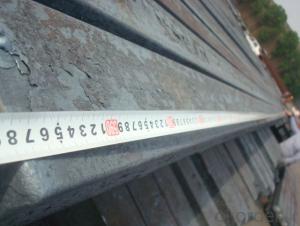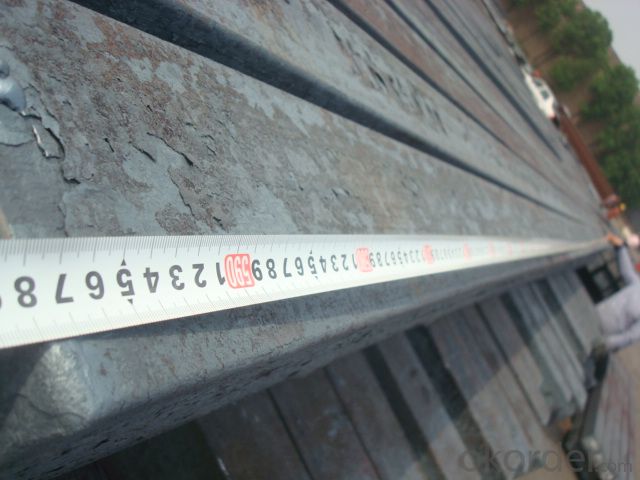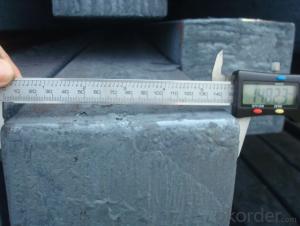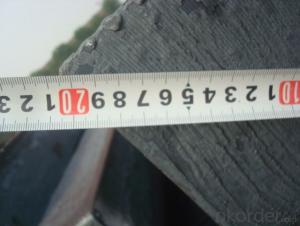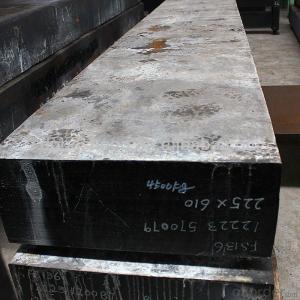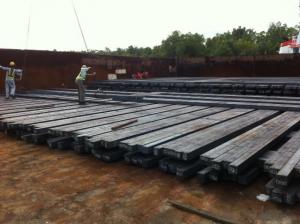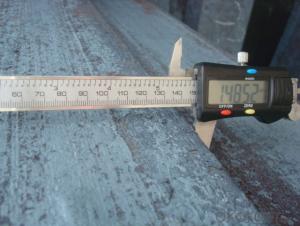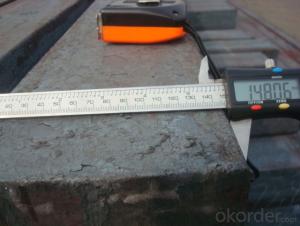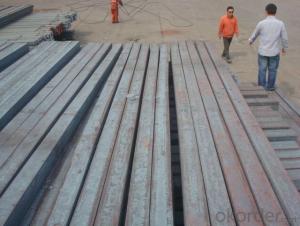Steel Billets/Blooms by Continue Casting Blast Furnace
- Loading Port:
- Tianjin
- Payment Terms:
- TT OR LC
- Min Order Qty:
- 1000 m.t.
- Supply Capability:
- 10000 m.t./month
OKorder Service Pledge
OKorder Financial Service
You Might Also Like
Steel Billets/Blooms by Continue Casting Blast Furnace
1.Structure of Steel Billets/Blooms by Continue Casting Blast Furnace
Continue Casting Steel Billet Manufactured By Blasting Furnace is the raw material of all kinds of steel mill. Billet section of square, round, flat, rectangular and abnormity, etc Several, mainly related to shape of rolled products. Simple rolled section steel, choose cross section of square billet or rectangular billet. rolling The sector products such as flat steel, Angle steel, select the rectangular billet or slab. Had better profiled billet when production beams, channels, and in rolling process Lines and improve the yield. The raw material of round billet is the production of seamless tube.
2.Main Features of Steel Billets/Blooms by Continue Casting Blast Furnace.
Continue Casting Steel Billet Manufactured By Blasting Furnace section size should meet the requirements of rolling deformation and finished product quality, but also roll strength and biting condition of restrictions. General steel Billet section height H. And the roll diameter D The ratio of the ( namely H/D) Should be less than or equal to zero 0.5 . Length of steel billet by finishing temperature, Rolling time and the length of the product Or times ruler. When heated too long accident prone to bump the furnace wall of steel, too short, furnace bottom utilization rate is not high, influence the heating furnace production. For the production Choose a variety of steel and steel billet, should consider the affinities of billet, as far as possible in order to improve the productivity of the roughing mill, simplify the stock management of workshop.
There are three shapes of the steel billets: square billet, slab, rectangular billet The Chinese billet, rectangular billet is mainly suitable for rolling hot rolled strip, building reinforced bar, Ordinary wire, high speed wire rod and various small profile. Of the slab are mainly used for rolling plate and hot coil sheet.
3. Steel Billets/Blooms by Continue Casting Blast Furnace Images
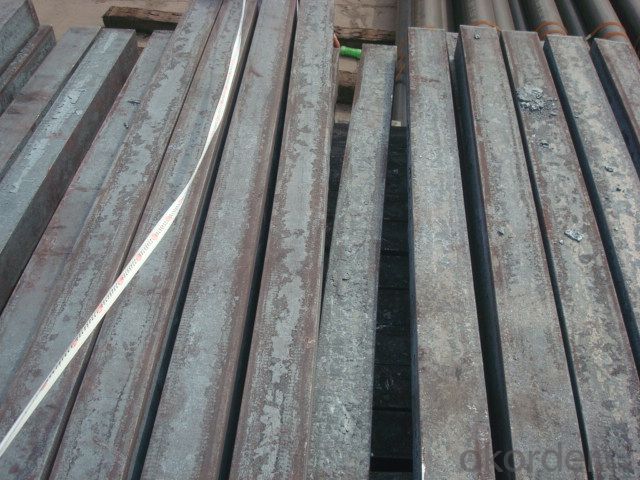
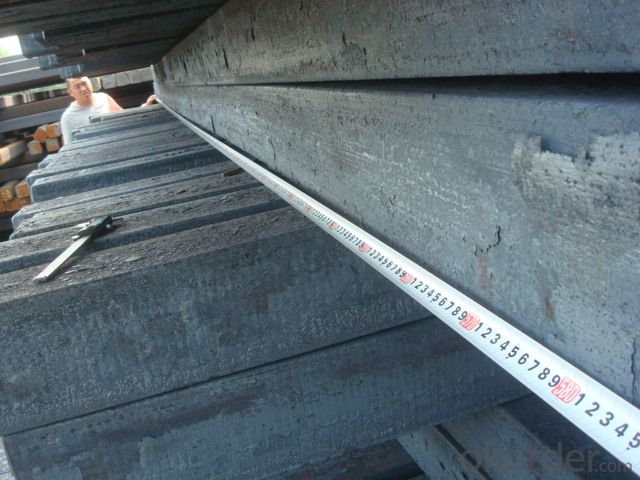
4. Steel Billets/Blooms by Continue Casting Blast FurnaceSpecification
Continue Casting Steel Billet Manufactured By Blasting Furnace rolled steel, after processing can be used for mechanical parts, forging parts, processing all kinds of steel, steel Q345B channel steel, wire rod is the role of the billet. Steel billet is used in the production of semi-finished products, generally cannot be used directly for the society. Steel billets and steel are strictly divided into standard, cannot decide to whether the business enterprise of the final product, and according to unified standards to perform the whole society. Typically, billet and the steel is relatively easy to distinguish, but for some steel billet, and have the same specification and same steel purposes (such as rolling tube billet), whether can be used for other industries, whether through steel processing process, whether through a finished product rolling mill processing to distinguish
Material standard The editor Range of thickness: 150-240 - mm + / - 5 mm width range: 880-1530 - mm + / - 20 mm Length: 3700-10000 - mm + / - 500 - mm Cross-sectional size: 64 * 64; 82 * 82; 98 * 98; 124 * 124; 120 * 150; 152 * 164; 152 * 170 mm Length: 9000 mm Section of tolerance: billet: 1.0 + / - 2.0-1.0 + / - 1.0 mm slab: width: + / - 2.0 mm thickness: + / - 3.0 mm The length tolerance: + / - 200 mm Section diagonal tolerance: 3.5-8.0 MM Billet section size protrusions requirements: < 1242 mm, do not allow; > = 1242 mm, < = 2 mm 1242 mm, < = 3 mm Beheading (shear) extension deformation: < 1242 mm billet: no control; The slab: < = 15 mm Surface tilt: no more than billet section 0.1 Bending: every 1 m length is not more than 10 mm The distortion: length < = 5 m, < = 11. ; The length of the < = 7.5 M, < = 5. Material % 3 sp/PS chemical composition: C Mn Si S P
5.FAQ of Steel Billets/Blooms by Continue Casting Blast Furnace
We have organized several common questions for our clients,may help you sincerely:
①How about your company?
A world class manufacturer & supplier of castings forging in carbon steel and alloy steel,is one of the large-scale professional investment casting production bases in China,consisting of both casting foundry forging and machining factory. Annually more than 8000 tons Precision casting and forging parts are exported to markets in Europe,America and Japan. OEM casting and forging service available according to customer’s requirements.
②How to guarantee the quality of the products?
We have established the international advanced quality management system,every link from raw material to final product we have strict quality test;We resolutely put an end to unqualified products flowing into the market. At the same time, we will provide necessary follow-up service assurance.
③How do you determine the billet section size?
Determination of billet section size in addition to considering the deformation of rolled piece to have enough quantity to meet the finished productThe quality requirements, but also should consider to roll strength and rolling bite into the limitations. The deformation size has a great influence on the product performance.Can make the metal internal organization and deformationPerformance can not meet the quality requirements.Such as high speed steel must have enough deformation,The carbide networkTo be broken or heavy rail and seamlessSteel pipeBy the total elongation coefficient of steel ingot to the finished product usually must alsoGuarantee up to50).
- Q: How are steel billets labeled for identification purposes?
- Steel billets are labeled for identification purposes using a combination of alphanumeric codes and markings. These labels provide crucial information about the steel billet's composition, size, and other important details. The most common method of labeling steel billets involves stamping or engraving the required information directly onto the surface of the billet. This can include details such as the grade of steel, heat number, lot number, and the manufacturer's symbol or logo. These markings are typically made using industrial-grade ink or through a process called electrochemical etching, which ensures durability and legibility even in harsh environments. Additionally, steel billets may also have identification tags or labels attached to them, providing further information that cannot be easily engraved or stamped. These tags or labels may include barcodes, QR codes, or RFID tags, which can be scanned or read using specialized equipment to quickly access the relevant information. By using these labeling methods, steel billets can be easily identified, tracked, and traced throughout their lifecycle, ensuring quality control, inventory management, and efficient production processes in the steel industry.
- Q: What are the different methods of steel billet surface honing?
- There are several different methods of steel billet surface honing, each serving a specific purpose and achieving different results. Some of the common methods include: 1. Manual Honing: This traditional method involves using hand-held honing tools, such as stones or abrasive pads, to manually remove any imperfections or rough surfaces from the steel billet. Skilled operators carefully rub the honing tool along the surface of the billet until the desired smoothness is achieved. 2. Mechanical Honing: In this method, mechanical honing machines are used to automate the honing process. These machines are equipped with rotating abrasive stones or pads that move along the surface of the billet, removing any irregularities. Mechanical honing allows for a more consistent and precise honing process, with the ability to control factors such as pressure, speed, and contact area. 3. Diamond Honing: Diamond honing is a specialized method that utilizes diamond-coated tools to achieve a high level of precision and smoothness. The diamond particles on the honing tool provide superior cutting capabilities, allowing for the removal of even the smallest imperfections. This method is often used for honing high-quality steel billets that require a flawless surface finish. 4. Hydrohoning: Hydrohoning, also known as abrasive flow machining, involves using a viscous abrasive medium that is forced through the billet's internal passages to remove any surface irregularities. This method is especially effective for honing complex shapes or internal surfaces that are difficult to reach through other methods. The abrasive medium can be adjusted to achieve different levels of surface finish. 5. Electrochemical Honing: Electrochemical honing is a technique that combines the principles of electrochemical machining and honing. It involves using a special electrolyte solution and a honing tool with an electrode to remove material from the billet's surface. This method is effective for honing hard materials and achieving a smooth, mirror-like finish. These are just some of the different methods of steel billet surface honing. The choice of method depends on factors such as the desired surface finish, the complexity of the billet's shape, the material being honed, and the level of precision required.
- Q: Can steel billets be used in the production of medical equipment?
- Certainly, medical equipment can utilize steel billets. Renowned for its robustness, longevity, and resistance to deterioration, steel proves to be an optimal substance for fabricating diverse medical apparatus. Steel billets, the preliminary intermediate product in steel production, can undergo additional processing and molding to form precise components or parts indispensable for medical equipment. Such components encompass surgical instruments, implants, orthopedic devices, needles, and other medical implements. The mechanical attributes of steel and its capacity to endure sterilization procedures render it a fitting preference for manufacturing dependable and secure medical equipment.
- Q: How is the demand for steel billets projected to change in the future?
- The demand for steel billets is expected to increase in the future due to the growing infrastructure development, urbanization, and industrialization across various regions. Additionally, the automotive and manufacturing sectors are anticipated to drive the demand for steel billets as they continue to expand. Overall, the future outlook for the demand of steel billets is positive and is expected to witness a steady rise.
- Q: Are steel billets used in the manufacturing of tools?
- Yes, steel billets are commonly used in the manufacturing of tools. Steel billets are semi-finished steel products that are typically hot-rolled or forged into various shapes, including bars, rods, and sheets. These billets serve as the primary raw material in tool manufacturing, as they provide the necessary strength, durability, and machinability required for producing high-quality tools. By shaping and machining the steel billets, manufacturers can create a wide range of tools such as wrenches, hammers, screwdrivers, drill bits, and cutting tools. The use of steel billets ensures that these tools possess the necessary hardness, toughness, and resistance to wear and tear, making them reliable and long-lasting. Therefore, steel billets play a crucial role in the production of tools, contributing to the overall efficiency and functionality of various industries.
- Q: What are the different types of steel billet casting methods?
- Steel billet casting employs various techniques, each boasting its own merits and applications. Among the most prevalent approaches are continuous casting, static casting, and centrifugal casting. 1. Continuous Casting: As the most extensively employed method, continuous casting entails pouring molten steel into a water-cooled mold. Within this mold, the steel solidifies into an uninterrupted strand, subsequently divided into desired lengths by a cutting apparatus. Continuous casting enables high production rates and consistent quality, rendering it optimal for mass production of steel billets. 2. Static Casting: Also referred to as ingot casting, this technique involves pouring molten steel into an immobile mold, which facilitates solidification into a solid billet. Typically composed of sand or metal, the mold allows for controlled solidification, enabling the attainment of desired properties. Static casting finds application in smaller production runs or when specific alloy compositions or shapes are required. 3. Centrifugal Casting: Employing centrifugal force, this method ensures the even distribution of molten steel within a rotating mold. As the mold spins, the molten steel is propelled towards the mold walls, resulting in a uniform casting with enhanced density and mechanical properties. Centrifugal casting is frequently employed for large and intricate billets, such as those indispensable in pipe manufacturing or turbine components. Although these represent the principal techniques employed in steel billet casting, variations or combinations of these methods may exist, contingent upon specific requirements or technological advancements.
- Q: Can steel billets be polished for improved surface finish?
- Yes, steel billets can be polished to achieve an improved surface finish. Polishing is a mechanical process that involves removing a thin layer of the material's surface to smooth out any imperfections or roughness. It can be done using various techniques such as abrasive polishing, chemical polishing, or electrochemical polishing. Polishing steel billets not only enhances their aesthetic appeal but also improves their functional properties. A polished surface reduces friction, which can be beneficial in applications where smooth movement or reduced wear is required. Additionally, a polished surface can improve the corrosion resistance of steel by creating a barrier against environmental factors. However, it is important to note that the extent to which a steel billet can be polished depends on its composition and properties. Some alloys may be more easily polished than others, and certain surface finishes may require more extensive polishing processes. It is also crucial to consider the desired application and the specific requirements for the steel billets before deciding on the appropriate polishing method.
- Q: Can steel billets be used in the production of utensils and cutlery?
- Yes, steel billets can be used in the production of utensils and cutlery. Steel billets are semi-finished products that can be further processed into various shapes and forms, including utensils and cutlery. Steel has excellent properties such as strength, durability, and corrosion resistance, which make it suitable for manufacturing utensils and cutlery. Steel billets are often melted and cast into specific shapes, then further processed through forging, stamping, or machining to create the desired utensils and cutlery items. The final products can range from spoons, forks, and knives to more intricate items like serving spoons, ladles, and cheese slicers. Steel utensils and cutlery are widely used and preferred due to their longevity and hygienic properties.
- Q: What are the common defects in billet? What's the cause?
- Five, X ray inspection, porosity, ultrasonic testing:One, 5, magnetic particle inspection, the back of the dent; 6, overheating and over burning: 1, penetrant inspection;Four. 2. The size of the weld does not meet the requirements and slag inclusion; 3 high-energy X-ray inspection, lamellar tearing and R ray flaw detection; 2;Five;Two: 1, arc crater;Methods for inspection of weld defects;
- Q: What are the different methods of surface cleaning for steel billets?
- Steel billets can be cleaned using various methods, each with its own benefits and applications. Let's explore these methods: 1. Shot Blasting: By propelling steel shots or grits at high speeds onto the billet surface, shot blasting effectively eliminates rust, mill scale, and other impurities, leaving behind a clean and textured surface. This technique is commonly employed to prepare billets for subsequent processes like painting or coating. 2. Acid Pickling: Acid pickling involves immersing the billets in an acid bath, typically hydrochloric or sulfuric acid. The acid reacts with surface oxides and scales, dissolving them and resulting in a clean surface. Acid pickling can remove a wide range of contaminants, but it must be carefully controlled to prevent hydrogen embrittlement. 3. Mechanical Cleaning: Mechanical cleaning techniques employ abrasive tools or equipment to physically scrub or scrape the billet surface. Wire brushes, abrasive pads, or sandpaper can be used to eliminate loose rust, scale, and dirt. This method is suitable for small-scale or localized cleaning but may be time-consuming for larger surfaces. 4. Water Jetting: Water jetting employs a high-pressure water stream to remove dirt, rust, and other contaminants from billet surfaces. The force of the water effectively eliminates loose debris without damaging the underlying steel. Water jetting is an environmentally friendly method that does not involve chemicals and is commonly used for light cleaning or maintenance purposes. 5. Chemical Cleaning: Chemical cleaning utilizes specialized chemicals or solutions to dissolve or neutralize contaminants on the billet surface. This method can be effective in removing stubborn stains, oils, or specific types of corrosion. However, careful selection and handling of chemicals are necessary to avoid any adverse effects on the steel or the environment. 6. Electrochemical Cleaning: Electrochemical cleaning, also known as electrolytic cleaning or electrocleaning, employs an electric current to remove surface contaminants. The billets are immersed in an electrolyte solution, and the application of an electric current causes the contaminants to dissolve or deposit onto an electrode. This method is particularly effective for removing organic contaminants or for precision cleaning. Each method possesses its own advantages and limitations. The choice of the appropriate surface cleaning method for steel billets depends on factors such as the type and severity of contamination, desired surface finish, and specific requirements of subsequent processes.
Send your message to us
Steel Billets/Blooms by Continue Casting Blast Furnace
- Loading Port:
- Tianjin
- Payment Terms:
- TT OR LC
- Min Order Qty:
- 1000 m.t.
- Supply Capability:
- 10000 m.t./month
OKorder Service Pledge
OKorder Financial Service
Similar products
Hot products
Hot Searches
Related keywords
